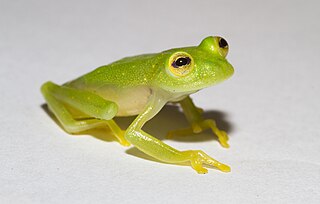
The glass frogs belong to the amphibian family Centrolenidae, native to the Central American Rainforests. The general background coloration of most glass frogs is primarily lime green, the abdominal skin of some members of this family is transparent and translucent, giving the glass frog its common name. The internal viscera, including the heart, liver, and gastrointestinal tract, are visible through the skin. When active their blood makes them visible; when sleeping most of the blood is concealed in the liver, hiding them. Glass frogs are arboreal, living mainly in trees, feeding on small insects and only coming out for mating season. Their transparency conceals them very effectively when sleeping on a green leaf, as they habitually do. However, climate change and habitat frangmentation has been threatening the survival rates of the family.

Hyalinobatrachium is a genus of glass frogs, family Centrolenidae. They are widely distributed in the Americas, from tropical Mexico to southeastern Brazil and Argentina.

The fringe-lipped bat is a leaf-nosed bat from southern Mexico to Bolivia and southern Brazil. It has three subspecies and no known fossils. It is the only species within its genus.
Hyalinobatrachium esmeralda is a species of frogs in the family Centrolenidae. It is endemic to Colombia and only known from the eastern slope of the Cordillera Oriental in Boyacá and Casanare Departments at elevations of 1,600–1,750 m (5,250–5,740 ft) above sea level.

Hyalinobatrachium fleischmanni, also known as Fleischmann's glass frog or the northern glass frog, is a species of frog in the family Centrolenidae. It is found in the tropical Americas from southern Mexico to Ecuador. Specifically, these frogs occur in Mexico, Belize, Costa Rica, El Salvador, Guatemala, Honduras, Nicaragua, and Panama, Colombia, and Ecuador. Notice that this and related species have often been confused with each other, and the exact distribution depends on the source. This frog tends to have green skin, pale yellowish spots, yellow fingertips and translucent skin covering its stomach.
Hyalinobatrachium fragile is a species of frog in the family Centrolenidae. It is endemic to the Venezuelan Coastal Range. In Spanish it is known as ranita de cristal fragil.
Hyalinobatrachium guairarepanense is a species of frog in the family Centrolenidae. It is endemic to Venezuela, where it is found in locations in the Coastal Range at elevations between 720 and 1,000 m above sea level.

Hyalinobatrachium iaspidiense is a species of frog in the family Centrolenidae from South America. Its specific name refers Quebrada de Jaspe, its type locality.
Hyalinobatrachium ibama is a species of frog in the family Centrolenidae. It is found in the Cordillera Oriental, Santander Department, Colombia, and in Barinas, Venezuela.
Hyalinobatrachium mondolfii is a species of frog in the family Centrolenidae from northern South America.
Hyalinobatrachium munozorum, also known as Upper Amazon glass frog, is a species of frog in the family Centrolenidae. It is found in the upper Amazon Basin in Ecuador, Colombia, and northern Bolivia; it is presumably to be found in intervening Peru; earlier records from Peru have been assigned to Hyalinobatrachium carlesvilai.

Hyalinobatrachium pellucidum, also known as the Rio Azuela glass frog, is a species of frog in the family Centrolenidae. It is found in lower montane rainforests on the Amazonian Andean slopes in Ecuador and Peru. The specific name pellucidum is Latin for "transparent" and refers to the transparent parietal peritoneum of this species.

The powdered glass frog or Chiriqui glass frog is a frog species in the glass frog family (Centrolenidae). The species is found from north-central Honduras south to northwestern Ecuador.

Hyalinobatrachium taylori is a species of frog in the family Centrolenidae. Its common name is Taylor's glass frog, and in Spanish, ranita de cristal de Taylor. It may represent at least two distinct species.

Hyalinobatrachium valerioi, sometimes known as the La Palma glass frog, is a species of frog in the family Centrolenidae. It is found in central Costa Rica and south to Panama and the Pacific lowlands and slopes of western Colombia and Ecuador; also in the Magdalena River Valley of Colombia.

Hyalinobatrachium vireovittatum is a species of frog in the family Centrolenidae. It is found in scattered localities in Costa Rica and west-central Panama. It has, however, been suggested that most populations actually represent Hyalinobatrachium talamancae, with Hyalinobatrachium vireovittatum restricted to its type locality in the San Isidro de El General district.









